Site Guide to Tuyttens Road Wetlands, Agassiz - Feb 22, 2009 (updated July 15, 2012)
By K. R. Jones
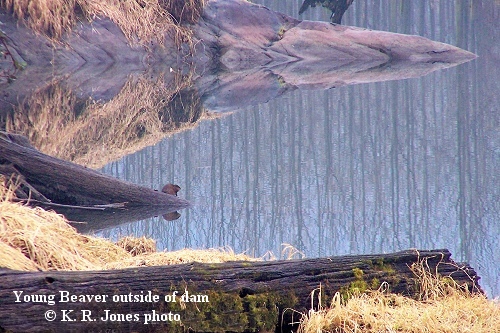
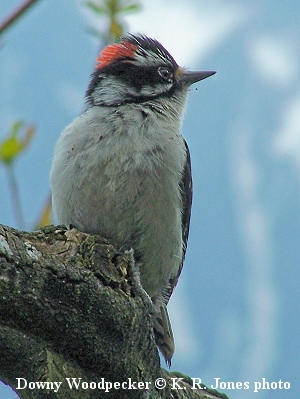 Directions Directions
Head into Agassiz, crossing the Agassiz/Rosedale Bridge and turn left on to Whelpton Rd.., continue to Tuyttens Rd.. and turn left. Follow Tuyttens, along the Agassiz Slough, then pass "Little Mountain" and you reach the Dyke. The Dyke is know as Cutler Rd. and runs along the slough to the foot of Hopyard Mountain, close to the slough mouth on the Fraser River. Tuyttens Rd. crosses the slough, and then reaches Whorley Rd. to the right, which follows a small backwater. Tuyttens turns to gravel and continues to another good area, an orphaned section of Bridge Rd., running along the Fraser River.
The Dyke, the fill along Tuyttens that crosses the slough and Whorley Rd. form a horseshoe shaped route that is a prime birding area. Please respect the sloughs and private property. Use caution - there are heavy farm vehicles and construction company vehicles daily in this area.
Introduction
The wetlands around Tuyttens Roa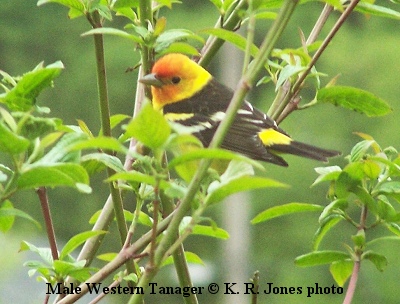 d, from Whelpton Road south to the Fraser River, features the Cheam and Agassiz sloughs, Hopyard Mountain and Little Mountain and supports a variety a of different species and hosts a number of migratory species. The writer has personally documented 150 species for the area between 2001 and 2008. d, from Whelpton Road south to the Fraser River, features the Cheam and Agassiz sloughs, Hopyard Mountain and Little Mountain and supports a variety a of different species and hosts a number of migratory species. The writer has personally documented 150 species for the area between 2001 and 2008. The Sto:lo Atlas shows early First Nations habitation of the area, with European land clearing, cottonwood milling and farming starting in the late 1800s. The sloughs have been altered during the years, including dredging to provide material for dykes in the 1930s and 40s. Continual washing out of the Tuyttens Rd. bridge during 60s and 70s prompted replacement by a fill road and culvert. Unfortunately for fish, the culvert is perched for part of the year. Now more farmland than wetlands, lower areas outside the dyke do regularly flood during May and June.
Almost all locals own dogs to keep 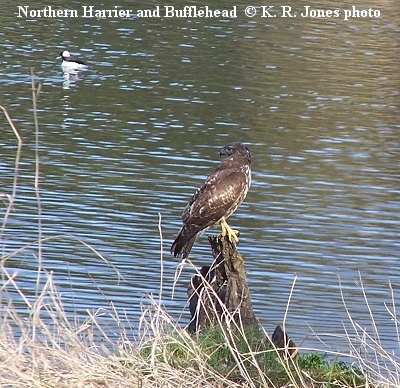 the coyotes at bay. A number of Agassiz residents bring their dogs out for a walk, the area is also open to duck hunters and quads and dirt bikers often tear up the sloughs during low-water. Despite all this, the area regularly hosts coyotes, otters, muskrat, rabbits, raccoons and the occasional bear. There is also a beaver dam at the intersection of the Cheam and Agassiz sloughs. Turtles and carp are present and salmon are seen in Fall from the mouth of the slough to where Tuyttens Road blocks the slough. On the Agassiz Slough, just north of Little Mountain, the endangered Salish Sucker was found and some riparian restoration is taking place in the area. the coyotes at bay. A number of Agassiz residents bring their dogs out for a walk, the area is also open to duck hunters and quads and dirt bikers often tear up the sloughs during low-water. Despite all this, the area regularly hosts coyotes, otters, muskrat, rabbits, raccoons and the occasional bear. There is also a beaver dam at the intersection of the Cheam and Agassiz sloughs. Turtles and carp are present and salmon are seen in Fall from the mouth of the slough to where Tuyttens Road blocks the slough. On the Agassiz Slough, just north of Little Mountain, the endangered Salish Sucker was found and some riparian restoration is taking place in the area.
Year Round Birds
Most days, between 2 to 6 Great Blue Herons are usually seen on the sloughs or up in the Cottonwoods. Mallards are the most common duck, seen both on sloughs and in farm fields. Wood Duck year-round numbers have been increasing over the last few years, and off and on over the year Hooded Mergansers, Common Mergansers and Ring-necked Ducks, American Widgeons, Buffleheads and Gadwalls are present. Bald Eagles, Red-tailed and Sharp-shinned Hawks are the most common raptors, with Cooper's Hawks and Northern Harriers observed regularly through the year, as well as the occasional Rough-legged Hawk.
Great Horned Owls are usually heard on Hopyard Mountain and Barn Owls often patrol the area and are sometimes seen at dusk. Downy Woodpeckers and Northern Flickers are common with a pair of Pileated Woodpeckers regularly dropping by. The most common songbirds are Black-capped Chickadees, Song Sparrows and House Sparrows, which are slowly increasing in numbers. Other birds present most of the year, are Stellar's Jay , Northwestern Crows, Belted Kingfishers, Killdeer, Rock Pigeons, White-crowned, Gold-crowned and Fox Sparrows, Starlings, Winter Wrens and House Finches.
Seasonal Birds During Winter, the water levels on the sloughs are quite low, which attracts Green-winged Teals. Although they are divers, Common Goldeneyes are occasionally seen, mostly during winter. Trumpeter Swans are common in the surrounding fields and occasionally in the sloughs, and of course Glaucous-winged Gulls are common at the river and in the fields, particularly when the manure spreading starts. The a few of the numerous Double-crested Cormorants at the river travel up the sloughs. Purple Finches also seem to prefer winter, as do Varied Thrush. For the past two years, Bohemian Waxwings have appeared during winter.
American Robins and Belted 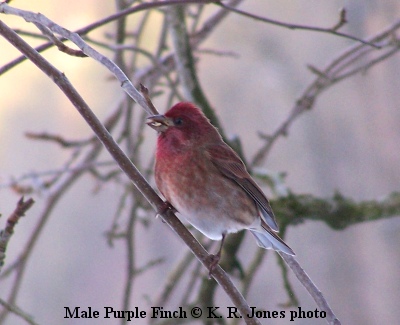 Kingfishers arrive so early in the year that they are almost resident year round. As the days lengthen, Red-winged Blackbirds show up in numbers before moving out along the sloughs for breading. American Kestrel and Peregrine Falcons tend to arrive in Spring, then Turkey Vultures arrive to be common overhead along with Osprey making a number of appearances. Blue-winged and Cinnamon Teals replace the Green-winged Teals as water levels rise. Greater Yellowlegs and Long-billed Dowitchers arrive first then Spotted Sandpiper, which are then more common throughout the season. Least and Western Sandpiper and Wilson's Phalarope have also been recorded in the area during the spring and fall migration (May and July/August) Pied-Billed Grebes return with higher water and often nest in the area. Kingfishers arrive so early in the year that they are almost resident year round. As the days lengthen, Red-winged Blackbirds show up in numbers before moving out along the sloughs for breading. American Kestrel and Peregrine Falcons tend to arrive in Spring, then Turkey Vultures arrive to be common overhead along with Osprey making a number of appearances. Blue-winged and Cinnamon Teals replace the Green-winged Teals as water levels rise. Greater Yellowlegs and Long-billed Dowitchers arrive first then Spotted Sandpiper, which are then more common throughout the season. Least and Western Sandpiper and Wilson's Phalarope have also been recorded in the area during the spring and fall migration (May and July/August) Pied-Billed Grebes return with higher water and often nest in the area.
Ruby-crowned Kinglets and Rufous Hummingbirds usually arrive at end of March or beginning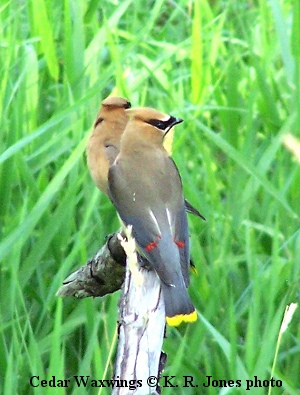 of April. The Tree and Violet-green Swallows arrive first with Barn, Cliff and occasionally Northern Rough-winged Swallows and finally Vaux's Swift arriving later. Brown-headed Cowbirds also appear early in the season, followed by Lincoln's and Savannah Sparrows then Bullock's Orioles and Cedar Waxwings . Later, Western Wood-Peewees and Eastern Kingbirds are common with a few different Empids always present. Yellow-rumped Warblers are the first to arrive, leave during Summer and appear again in the Fall. Wilson's then Common Yellowthroats are the most common warblers through the season, nesting along the slough banks. Orange-crowned Warblers are next most common with the occasional, Black-throated Grey, Yellow and MacGillivray's. Shorebird species can be found in of April. The Tree and Violet-green Swallows arrive first with Barn, Cliff and occasionally Northern Rough-winged Swallows and finally Vaux's Swift arriving later. Brown-headed Cowbirds also appear early in the season, followed by Lincoln's and Savannah Sparrows then Bullock's Orioles and Cedar Waxwings . Later, Western Wood-Peewees and Eastern Kingbirds are common with a few different Empids always present. Yellow-rumped Warblers are the first to arrive, leave during Summer and appear again in the Fall. Wilson's then Common Yellowthroats are the most common warblers through the season, nesting along the slough banks. Orange-crowned Warblers are next most common with the occasional, Black-throated Grey, Yellow and MacGillivray's. Shorebird species can be found in
Rare Birds
Early 2009, a juvenile Northern Goshawk briefly appeared in the area. In 2008, a Least Flycatcher stayed for over a month in the Summer and a pair of Lewis's Woodpeckers stayed for a few days in the Fall. In the first half of the year, a Nashville Warbler stayed for a couple of days. A probable Male Western Bluebird was seen along the Dyke, close to Hopyard Mountain. The best documented rare bird in the area was the Ash-throated Flycatcher that lasted 6 weeks around Whorley Road in the Fall of 2007. Another was documented in mid June of 2011 just a couple hundred yards from the bird of 2007.

Also in 2007 an American Bittern was briefly seen by the Cheam Slough. An American Tree Sparrow observed in 2006 and a Harris's Sparrow in 2005. 2002 was a good year for rarities. In January, 4 Common Redpolls were observed for most of a day. In March a male Baikal Teal was seen on the Cheam Slough by the writer (no photo). Prior to 2001, another observer saw a Golden Eagle in the evergreen at the intersection of the Cheam and Agassiz sloughs. A Semipalmated Sandpiper was among a small flock of shorebirds in July of 2012 along Whorley Road. |